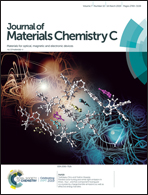Lead-free hybrid ferroelectric material based on formamidine: [NH2CHNH2]3Bi2I9†
Abstract
The extraordinary thermal stability of [NH2CHNH2]3Bi2I9 (FA3Bi2I9) crystals, up to around 600 K, has been enhanced by using the evaporating method. DSC measurements have revealed reversible structural phase transitions: at 203 K (Phase I → Phase II), 173 K (II → III), 134.7 K (III → IV), 131.4 K (IV → V), and 120 K (V → VI). The crystal structures of FA3Bi2I9 adopt the polar space groups P63mc at 220 K (Phase I) and Cmc21 at 190 K (Phase II). The pyroelectric current (Ipyr) measured in the temperature range covering all the phases of FA3Bi2I9 confirmed their polar nature. The reversibility of the spontaneous polarization in each phase has been confirmed by the observed hysteresis loops. All the phase transitions are dielectrically active. The dielectric response (ε*(ω,T) close to 134.7 and 131.4 K) is characteristic of ferroelectrics with a critical slowing-down process. Optical bandgaps estimated from the UV-vis measurements and calculated using the DFT method are equal to 1.85 and 1.89 eV, respectively. On the basis of the structural, dielectric, and spectroscopic results, the molecular mechanisms of the phase transitions have been proposed.
![Graphical abstract: Lead-free hybrid ferroelectric material based on formamidine: [NH2CHNH2]3Bi2I9](/en/Image/Get?imageInfo.ImageType=GA&imageInfo.ImageIdentifier.ManuscriptID=C8TC06458J&imageInfo.ImageIdentifier.Year=2019)
- This article is part of the themed collections: 2019 Journal of Materials Chemistry C HOT Papers and International Year of the Periodic Table : From Pb and Sn Perovskites to the Next Generation


 Please wait while we load your content...
Please wait while we load your content...